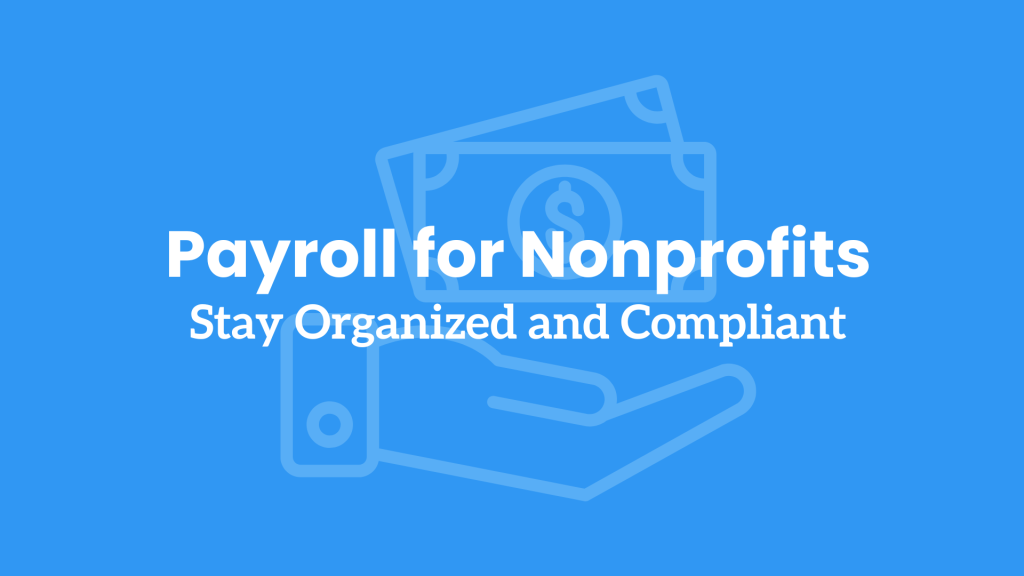Payroll Basics for Nonprofits: How to Stay Organized and Compliant
Estimated reading time: 11 minute(s)

What Every Organization Should Know
Running payroll as a nonprofit may look a little different from a business, but the essentials are the same: you need to pay staff and contractors correctly, keep accurate records, and follow all federal and state tax rules. Clear payroll practices protect your organization, your employees, and your reputation.
1. Know Who You’re Paying
Before processing any payments, identify each worker’s correct classification.
- Employees: Individuals who work under your direction and schedule. You are responsible for withholding and paying employment taxes for them.
- Independent contractors: Individuals or companies hired for a specific project or service. They handle their own taxes and receive a Form 1099 at year’s end.
- Volunteers: People who freely donate their time. They should not receive compensation, though you may reimburse approved expenses.
Classify everyone accurately to stay compliant with IRS rules and avoid penalties.
2. Register Your Organization for Payroll
If you have paid employees, you need to:
- Obtain an Employer Identification Number (EIN) from the IRS.
- Register with your state for income tax withholding and unemployment insurance.
- Keep track of local requirements, such as city payroll taxes or additional filings.
3. Collect and Store Employee Information
Before running payroll, gather and securely store required documents:
- Form W-9 or Form W-4 for federal income tax withholding
- State tax withholding form (if applicable)
- Direct deposit authorization
- Form I-9 for employment eligibility verification
Keep personnel and tax records in a secure and organized system.
4. Understand Payroll Taxes
Nonprofits are not automatically exempt from payroll taxes. You must withhold and remit the following for employees:
- Federal income tax
- Social Security and Medicare (FICA)
- State and local taxes, where applicable
Your organization also contributes the employer’s share of FICA and Federal Unemployment Tax (FUTA) unless you qualify for an exemption as a 501(c)(3).
Independent contractors are paid in full with no withholdings, but you must issue them a Form 1099-NEC if they earn $600 or more in a calendar year.
5. Choose a Payroll System
You can process payroll in several ways:
- Manual payroll: Not recommended for most organizations because of compliance risk.
- Payroll software or service: Automates calculations, tax filings, and payments.
- Free or low-cost nonprofit payroll tools: Some platforms, such as TaxBandits’ Free Payroll, are designed specifically for small nonprofits and can simplify setup.
6. Set a Regular Pay Schedule
Establish consistent pay periods (weekly, biweekly, or monthly) and communicate them clearly. Regular schedules build trust with staff and help ensure timely tax filings.
7. Keep Accurate Payroll Records
Maintain payroll records for at least four years, including:
- Gross pay and deductions
- Pay dates and methods
- Copies of W-2s and 1099s
- Proof of tax deposits and filings
Accurate records protect your nonprofit in case of audit or funding review.
8. Prepare for Year-End Reporting
At the end of each year, you must:
- File Form W-2 for employees and send copies to the IRS and SSA.
- File Form 1099-NEC for contractors.
- Reconcile all payroll tax payments and filings for accuracy.
9. Plan for Contractors and Events
If your nonprofit hires temporary contractors or event workers for campaigns like GivingTuesday, be sure to:
- Have a written contract outlining payment terms.
- Collect a Form W-9 before issuing payment.
- Use your payroll system to track these payments so you can issue 1099s easily later.
Final Tip
Even though nonprofits are mission-driven, compliance still matters. Clear payroll procedures help you remain transparent, protect your tax-exempt status, and build confidence with funders and employees.
If you need an affordable way to handle payroll for employees or contractors, visit TaxBandits.com to learn more about nonprofit payroll solutions and tools.



Leave a Comment